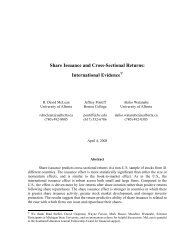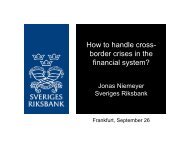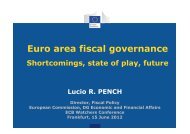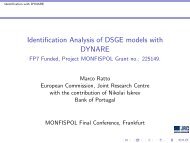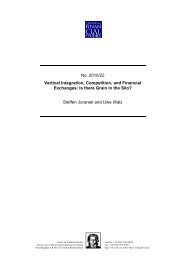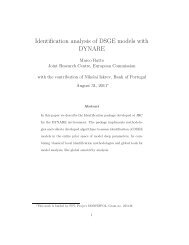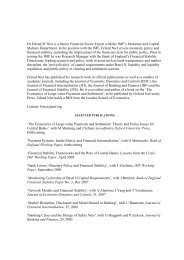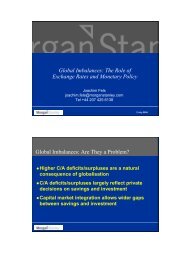Forecasting and Policy Making (Paper) - Center for Financial Studies
Forecasting and Policy Making (Paper) - Center for Financial Studies
Forecasting and Policy Making (Paper) - Center for Financial Studies
Create successful ePaper yourself
Turn your PDF publications into a flip-book with our unique Google optimized e-Paper software.
Further below we review in more detail the <strong>for</strong>ecasting methodology <strong>and</strong> processes of the Federal<br />
Reserve staff, the Eurosystem staff <strong>and</strong> the Bank of Engl<strong>and</strong>. A very useful though somewhat dated<br />
overview of <strong>for</strong>ecasting practices at central banks is given in Robertson (2000).<br />
International institutions <strong>and</strong> private sector <strong>for</strong>ecasts<br />
Other important <strong>for</strong>ecasts that receive considerable attention by governments <strong>and</strong> the press are the<br />
International Monetary Fund’s (IMF) World Economic Outlook <strong>and</strong> the Organization <strong>for</strong> Economic<br />
Cooperation <strong>and</strong> Development (OECD) Economic Outlook. The IMF’s World Economic Outlook<br />
includes analysis <strong>and</strong> projections of the main macroeconomic aggregates <strong>for</strong> all IMF’s member coun-<br />
tries <strong>and</strong> is published twice a year. It is an integral element of the IMF’s surveillance process. The<br />
OECD’s Economic Outlook is a similar publication that covers the OECD member countries <strong>and</strong> is<br />
also published twice a year.<br />
Furthermore, there exist a variety of private sector <strong>for</strong>ecasts that are frequently mentioned in<br />
the press. Summaries of these <strong>for</strong>ecasts in the <strong>for</strong>m of surveys are in<strong>for</strong>mative <strong>for</strong> economic policy<br />
decisions. They provide an indication of private sector expectations. Furthermore, averages of the<br />
projections of many different <strong>for</strong>ecasters often turn out more accurate than individual <strong>for</strong>ecasts.<br />
Examples include the Survey of Professional Forecasters that is conducted by the Philadelphia Fed<br />
<strong>and</strong> the European counterpart that is conducted by the European Central Bank. Both surveys are<br />
conducted quarterly.<br />
The <strong>for</strong>ecasting methodology of the Federal Reserve staff<br />
The Federal Reserve staff produces <strong>for</strong>ecasts prior to each of the eight FOMC meetings per year<br />
with a <strong>for</strong>ecast horizon of about two years. The <strong>for</strong>ecasts provide a basis <strong>for</strong> discussions of the FOMC<br />
members, but need not reflect their own views about future economic developments. The <strong>for</strong>ecasts are<br />
conditioned on a specific future time path <strong>for</strong> the federal funds rate – the primary policy instrument<br />
of the FOMC. It is often assumed that the federal funds rate will be kept constant at the most recent<br />
level. At other times a decreasing or increasing path is assumed, especially if a constant interest rate<br />
path would be implausible. We will discuss different conditioning assumptions in detail in section<br />
5.6.<br />
As explained by Edge et al. (2010), Robertson (2000), <strong>and</strong> Reifschneider et al. (1997) the Federal<br />
Reserve staff <strong>for</strong>ecast is a judgmental projection that is derived from quantitative data, qualitative<br />
in<strong>for</strong>mation, different economic models, <strong>and</strong> various <strong>for</strong>ecasting techniques. The <strong>for</strong>ecast does not<br />
result from a mechanical run of any large-scale macroeconometric model; nor is it derived directly<br />
by add-factoring any such model. Instead, it relies heavily on the expertise of sector specialists <strong>and</strong><br />
senior advisers. The Federal Reserve’s structural macroeconomic model of the U.S. economy — the<br />
so-called FRB/US model 7 — is only one of the tools used as an input into the deliberations that lead<br />
to the Greenbook/Tealbook projection. According to the above-mentioned descriptions of the FRB<br />
staff <strong>for</strong>ecasting process, FRB/US model <strong>for</strong>ecasts are prepared at the same time as each Greenbook<br />
7 See Brayton <strong>and</strong> Tinsley (1996) <strong>and</strong> Reifschneider et al. (1999) <strong>for</strong> descriptions of the FRB/US model.<br />
8



